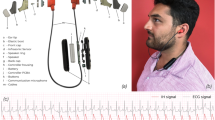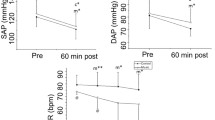Abstract
An anesthesiologist must remain vigilant of the patient’s clinical status, incorporating many independent physiological measurements. Oxygen saturation and heart rate are represented by continuous audible tones generated by the pulse oximeter, a mandated monitoring device. Other important clinical parameters—notably blood pressure—lack any audible representation beyond arbitrarily-configured threshold alarms. Attempts to introduce further continuous audible tones have apparently foundered; the complexity and interaction of these tones have exceeded the ability of clinicians to interpret them. Instead, we manipulate the tonal and rhythmic structure of the accepted pulse oximeter tone pattern melodically. Three melodic algorithms were developed to apply tonal and rhythmic variations to the continuous pulse oximeter tone, dependent on the systolic blood pressure. The algorithms distort the original audible pattern minimally, to facilitate comprehension of both the underlying pattern and the applied variations. A panel of anesthesia practitioners (attending anesthesiologists, residents and nurse anesthetists) assessed these algorithms in characterizing perturbations in cardiopulmonary status. Twelve scenarios, incorporating combinations of oxygen desaturation, bradycardia, tachycardia, hypotension and hypertension, were tested. A rhythmic variation in which additional auditory information was conveyed only at halftime intervals, with every other “beat” of the pulse oximeter, was strongly favored. The respondents also strongly favored the use of musical chords over single tones. Given three algorithms of tones embedded in the pulse oximeter signal, anesthesiologists preferred a melodic tone to signal a significant change in blood pressure.


Similar content being viewed by others
References
Craven RM, McIndoe AK. Continuous auditory monitoring—how much information do we register? Br J Anaesth. 1999;83:747–9.
American Society of Anesthesiologists. Standards for basic anesthetic monitoring. Park Ridge, IL: American Society of Anesthesiologists; 2011.
Santamore DC, Cleaver TG. The sounds of saturation. J Clin Monit Comput. 2004;18:89–92.
Chandra D, Tessler MJ, Usher J. Audio spectrum and sound pressure levels vary between pulse oximeters. Can J Anaesth. 2006;53:26–32.
Nazir T, Beatty PC. Anaesthetists’ attitudes to monitoring instrument design options. Br J Anaesth. 2000;85:781–4.
Watson M, Sanderson P, Russell WJ. Tailoring reveals information requirements: the case of anaesthesia alarms. Interact Comput. 2004;16:271–93.
Loeb RG, Fitch WT. A laboratory evaluation of an auditory display designed to enhance intraoperative monitoring. Anesth Analg. 2002;94:362–8 (table of contents).
de Man FR, Greuters S, Boer C, Veerman DP, Loer SA. Intra-operative monitoring—many alarms with minor impact. Anaesthesia 2013;68:804–10.
Harrison MJ, Connor CW. Statistics-based alarms from sequential physiological measurements. Anaesthesia. 2007;62:1015–23.
Connor CW, Gohil B, Harrison MJ. Triggering of systolic arterial pressure alarms using statistics-based versus threshold alarms. Anaesthesia. 2009;64:131–5.
IEC, editor. International Standard IEC60601-1-8 (2005–08): medical electrical equipment, part 1–8: general requirements for safety—collateral standard: general requirements, tests and guidance for alarm systems in medical electrical equipment and medical electrical systems. Geneva: International Electrotechnical Commission; 2005.
Wee AN, Sanderson PM. Are melodic medical equipment alarms easily learned? Anesth Analg. 2008;106:501–8 (table of contents).
Cage the Elephant (Musical group) and Copyright Collection (Library of Congress), [Cage the Elephant. Back against the wall—music video], 2009.
Connor CW. Pulse Oximetry Algorithms, Boston, MA 2013. Executable file for the Windows operating system. Available online at: http://www.mit.edu/~cwc/PulseOx.exe.
Altman DG, Bland JM. Diagnostic tests. 1: Sensitivity and specificity. BMJ. 1994;308:1552.
Altman DG, Bland JM. Diagnostic tests. 2: Predictive values. BMJ. 1994;309:102.
Acknowledgments
This work was supported by intradepartmental funds only. No external financial support was obtained.
Conflict of interest
The authors declare that they have no conflict of interest.
Ethical standards
The authors declare that the experiments comply with the current laws of the United States of America, the country in which they were performed.
Author information
Authors and Affiliations
Corresponding author
Additional information
The “supplementary material” refers to the software that we wrote that generates the auditory alarms described in the text, as shown in Fig. 2 and as cited in the references. The software may be obtained from this address: http://www.mit.edu/~cwc/PulseOx.exe.
Rights and permissions
About this article
Cite this article
Chima, R.S., Ortega, R. & Connor, C.W. Melodic algorithms for pulse oximetry to allow audible discrimination of abnormal systolic blood pressures. J Clin Monit Comput 28, 597–603 (2014). https://doi.org/10.1007/s10877-014-9558-6
Received:
Accepted:
Published:
Issue Date:
DOI: https://doi.org/10.1007/s10877-014-9558-6




